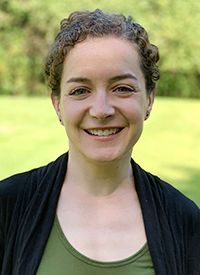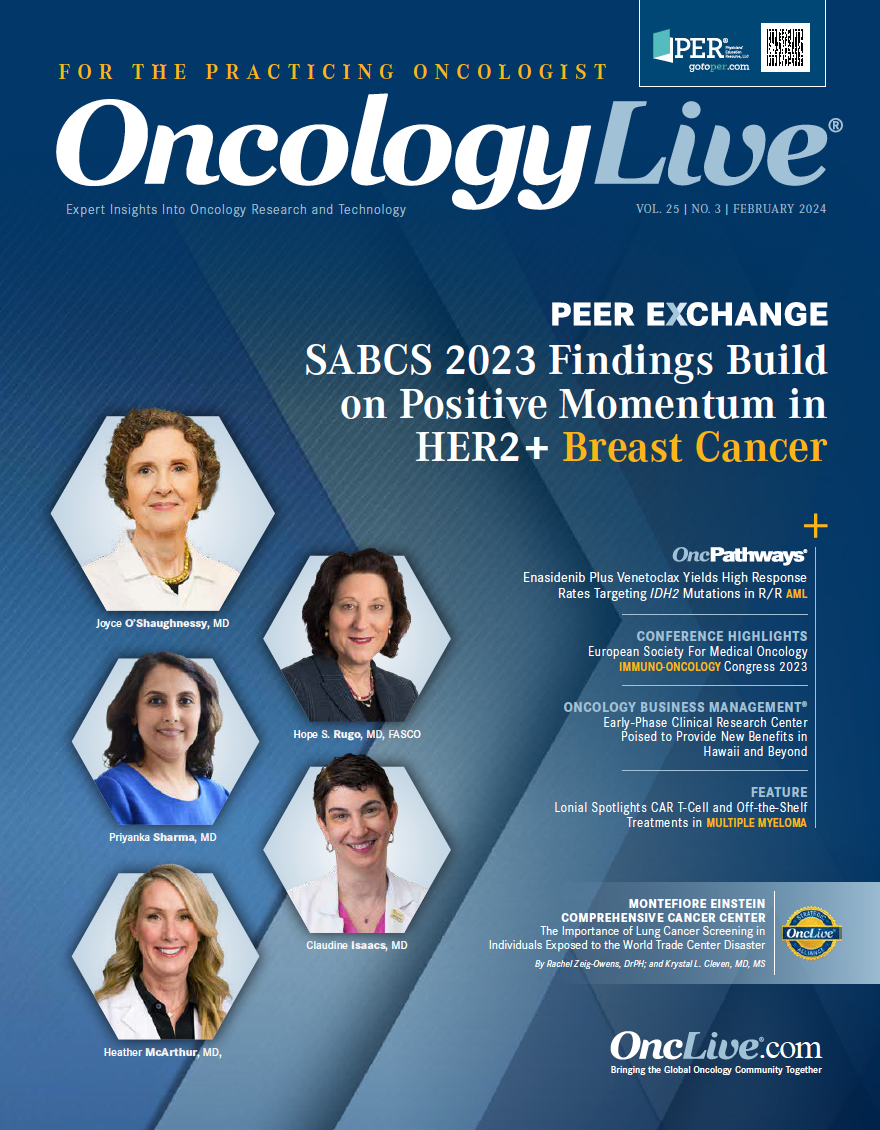Publication
Article
Oncology Live®
The Importance of Lung Cancer Screening in Individuals Exposed to the World Trade Center Disaster
Investigators evaluated risk factor–based guidelines and risk model–based strategies for lung cancer screening in World Trade Center–exposed responders.
Rachel Zeig-Owens, DrPH

In the United States, lung and bronchus cancer is the third most common cancer and causes the most cancer-related deaths.1 Despite advances in screening, early detection, and treatment, the national 5-year relative survival rate for patients with lung cancer remains only 25.4%.2 However, in sharp contrast, the 5-year survival rate for patients with localized lung cancer is significantly higher at 62.8%. Additionally, 5-year relative survival rates are 34.8% for regional, 8.2% for distant, and 15.1% for unknown stages (Figure).2 Low-dose CT (LDCT) screening leads to detection of lung cancer at a much earlier stage, thereby improving survival.3,4 An example of this mortality benefit was seen in the 2011 National Lung Screening Trial results, in which LDCT lung cancer screening exhibited a 20% (95% CI, 6.8%-26.7%; P = .004) relative reduction in lung cancer mortality compared with single-view posteroanterior chest radiography.4 According to a meta-analysis that pooled results from 9 randomized controlled trials, LDCT improves detection of early-stage lung cancers and reduces lung cancer mortality when compared with usual care/no screening or chest radiography.5
Figure. 5-Year Relative Survival Rate by Stage at Diagnosis2

Following the terrorist attacks in New York, New York, on September 11, 2001, there was great concern that the tens of thousands of individuals who were in the World Trade Center (WTC) area would develop cancer as a result of their exposure to known and suspected carcinogens such as asbestos, silica, polycyclic aromatic hydrocarbons, polychlorinated biphenyls, and dioxins.6,7 Soon after September 11, David J. Prezant, MD, chief medical officer for the Office of Medical Affairs at the Fire Department of the City of New York (FDNY) and a professor in the Department of Medicine (Pulmonary Medicine) and Department of Epidemiology & Population Health at Montefiore Einstein in Bronx, New York, began LDCT lung cancer screening for FDNY rescue and recovery workers based on their daily occupational exposures and exposures to WTC dust and gases. Lung cancer screening was offered to all WTC-exposed FDNY members with any history of smoking and/or intense WTC exposure, regardless of age.7
Krystal L. Cleven, MD, MS

In an effort to provide the best targeted screening to the WTC-exposed responders, we were interested in evaluating the accuracy and efficiency in occupational cohorts of both risk factor–based guidelines and risk model–based strategies for LDCT lung cancer screening.8 We chose to evaluate the 2014 United States Preventive Services Task Force (USPSTF) guidelines (the current version at the time and the most accepted in the United States); the National Comprehensive Cancer Network group 2 (NCCN-2) guidelines (which include other risk factors such as occupational exposures); the Prostate, Lung, Colorectal, and Ovarian Cancer Screening Trial model (PLCOm2012); and the Bach model.9-12 These model-based strategies were selected because they are well validated, and the Bach model includes occupational (asbestos) exposure.
Our study included 930 WTC-exposed FDNY rescue/ recovery workers who underwent a baseline CT scan and were eligible for 1 of 4 screening guidelines/ models.8 These findings, which were published in CHEST in 2021, demonstrated that 63 WTC-exposed firefighters and emergency medical services providers were diagnosed with lung cancer. The median age at diagnosis was 65 years (IQR, 57-71). Among the lung cancer cases, 56 (89%) were non–small cell carcinoma, including adenocarcinomas (n = 43), squamous cell carcinomas (n = 11), and large cell carcinomas (n = 2); 3 (4.8%) were small cell carcinoma; and 4 (6.3%) were other histologies. Of the 63 patients diagnosed with lung cancer, 50 individuals had their disease detected via LDCT screening, with 13 patients diagnosed based on clinical reasons other than screening.
All the patients who underwent LDCT screening were identified by the NCCN-2 guidelines. The USPSTF guidelines identified 28 patients, the PLCOm2012 model identified 32 patients, and the Bach model identified 29 patients. As such, the sensitivity of the NCCN-2 guidelines (79%) was determined to be greater than the USPSTF guidelines (44%), the PLCOm2012 model (51%), and the Bach model (46%). When reviewing the stage of diagnosis of the 50 cancers detected by LDCT screening, we found that 52% of the cases identified by the NCCN-2 guidelines were localized disease (stage I/ II). In contrast, the USPSTF guidelines, PLCOm2012 model, and Bach model identified a slightly lower proportion of localized disease (43%, 41%, and 38%, respectively). False-positive findings (suspicious nodules requiring follow-up that were not diagnosed as lung cancer by end of study) ranged from 79.7% to 83.8% (259/309 cases with NCCN-2 guidelines, 110/138 cases with USPSTF guidelines, 129/161 cases with the PLCOm2012 model, and 115/144 cases with the Bach model). Only a few patients required invasive procedures that did not result in a lung cancer diagnosis, ranging from 5.9% to 7.4% (4/54 cases with NCCN-2 guidelines, 2/30 cases with USPSTF guidelines, 2/34 cases with the PLCOm2012 model, and 2/31 cases with the Bach model).13
Based on these results, we concluded that compared with USPSTF guidelines, the PLCOm2012 model, and the Bach model, the NCCN-2 guidelines screened the largest number of people and demonstrated the highest sensitivity in detecting lung cancer but were also associated with the lowest specificity. Since the publication of our findings, the USPSTF updated its guidelines in 2020 by lowering the screening age from 55 years to 50 years and smoking history from at least 30 pack-years to at least 20 pack-years to match the NCCN-2 guidelines used in our study. When applied to this cohort exposed to occupational and environmental hazards, our findings are consistent with the 2020 USPSTF expanded screening guidelines.
Our study participants are unique in that their screening and subsequent treatments are covered at no cost under the US federal government’s WTC Health Program (WTCHP). Their free access to care along with screening at an earlier age prior to the 2020 USPSTF screening update likely contributed to improved survival.
In findings from a separate study published in the American Journal of Industrial Medicine in 2021, we observed a 26% reduction in the risk of death from lung cancer in WTC-exposed rescue/ recovery workers enrolled in the WTCHP compared with patients with cancer from the state of New York (relative rate, 0.74; 95% CI, 0.56-0.97).14 A similar benefit was not observed among WTC-exposed rescue/recovery workers who were not enrolled in the WTCHP and were thereby less likely to receive similar LDCT cancer screening.
Our study findings demonstrate that beginning lung cancer screening at the age of 50 years and in those with fewer pack-years likely contributes to improved survival after a lung cancer diagnosis.8 Findings from this study also highlight the importance of obtaining a complete exposure history when caring for patients and the need to tailor cancer screening guidelines for individuals who have unique environmental factors and occupational exposures such as those experienced at the WTC site on September 11, 2001, and in the months that followed.
Rachel Zeig-Owens, DrPH, is research assistant professor in the Department of Epidemiology & Population Health at Albert Einstein College of Medicine in Bronx, New York; member of the Cancer Epidemiology, Prevention & Control Research Program at Montefiore Einstein Comprehensive Cancer Center in Bronx; and director of epidemiology for the World Trade Center Health Program at the Fire Department of the City of New York in New York.
Krystal L. Cleven, MD, MS, is assistant professor of medicine in the Division of Pulmonary Medicine at Montefiore Health System and Albert Einstein College of Medicine and codirector of Montefiore Asthma Center, all in Bronx, New York.
References
- Cancer stat facts: common cancer sites. National Cancer Institute Surveillance, Epidemiology, and End Results Program. Accessed January 10, 2024. https://seer.cancer.gov/statfacts/html/common.html
- Cancer stat facts: lung and bronchus cancer. National Cancer Institute Surveillance, Epidemiology, and End Results Program. Accessed January 10, 2024. https://seer.cancer.gov/statfacts/html/lungb.html
- Ettinger DS, Wood DE, Akerley W, et al. NCCN Guidelines insights: non-small cell lung cancer, version 4.2016. J Natl Compr Canc Netw. 2016;14(3):255-264. doi:10.6004/jnccn.2016.0031
- Aberle DR, Adams AM, Berg CD, et al; National Lung Screening Trial Research Team. Reduced lung-cancer mortality with low-dose computed tomographic screening. N Engl J Med. 2011;365(5):395-409. doi:10.1056/NEJMoa1102873
- Huang KL, Wang SY, Lu WC, Chang YH, Su J, Lu YT. Effects of low-dose computed tomography on lung cancer screening: a systematic review, meta-analysis, and trial sequential analysis. BMC Pulm Med. 2019;19(1):126. doi:10.1186/s12890-019-0883-x
- Lioy PJ, Weisel CP, Millette JR, et al. Characterization of the dust/smoke aerosol that settled east of the World Trade Center (WTC) in lower Manhattan after the collapse of the WTC 11 September 2001. Environ Health Perspect. 2002;110(7):703-714. doi:10.1289/ehp.02110703
- Landrigan PJ, Lioy PJ, Thurston G, et al; NIEHS World Trade Center Working Group. Health and environmental consequences of the world trade center disaster. Environ Health Perspect. 2004;112(6):731-739. doi:10.1289/ehp.6702
- Cleven KL, Vaeth B, Zeig-Owens R, et al. Performance of risk factor-based guidelines and model-based chest CT lung cancer screening in World Trade Center-exposed fire department rescue/recovery workers. Chest. 2021;159(5):2060-2071. doi:10.1016/j.chest.2020.11.028
- Gray EP, Teare MD, Stevens J, Archer R. Risk prediction models for lung cancer: a systematic review. Clin Lung Cancer. 2016;17(2):95-106. doi:10.1016/j.cllc.2015.11.007
- Moyer VA; U.S. Preventive Services Task Force. Screening for lung cancer: U.S. Preventive Services Task Force recommendation statement. Ann Intern Med. 2014;160(5):330-338. doi:10.7326/M13-2771
- Wood DE, Kazerooni EA, Baum SL, et al. Lung cancer screening, version 3.2018, NCCN Clinical Practice Guidelines in Oncology. J Natl Compr Canc Netw. 2018;16(4):412-441. doi:10.6004/jnccn.2018.0020
- Tammemägi MC, Katki HA, Hocking WG, et al. Selection criteria for lung-cancer screening. N Engl J Med. 2013;368(8):728-736. doi:10.1056/NEJMoa1211776
- Bach PB, Kattan MW, Thornquist MD, et al. Variations in lung cancer risk among smokers. J Natl Cancer Inst. 2003;95(6):470-478. doi:10.1093/jnci/95.6.470
- Goldfarb DG, Zeig-Owens R, Kristjansson D, et al. Cancer survival among World Trade Center rescue and recovery workers: a collaborative cohort study. Am J Ind Med. 2021;64(10):815-826. doi:10.1002/ajim.23278









